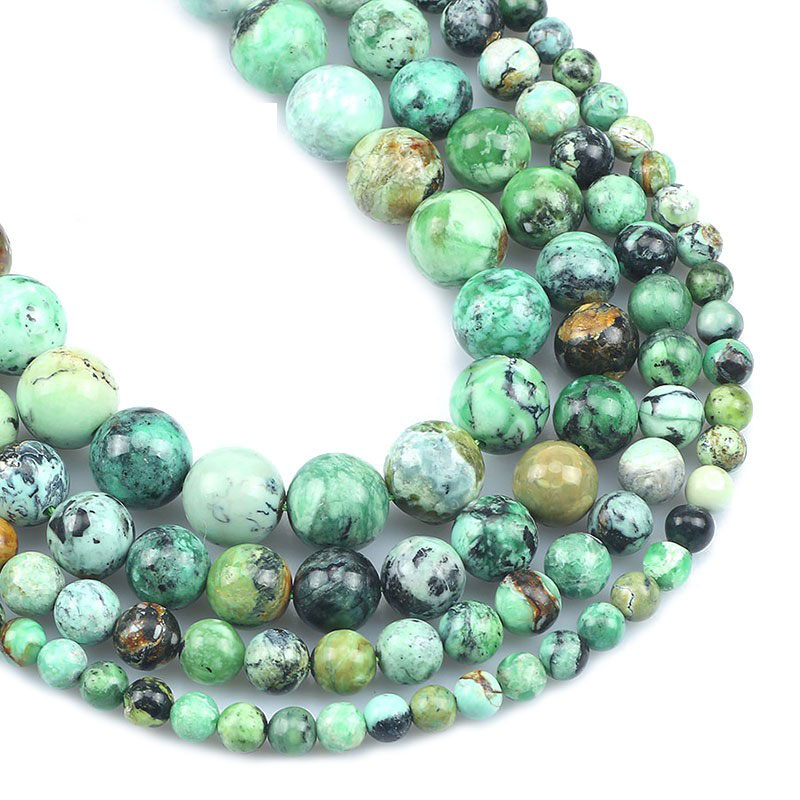Variscite has a long history as a gem material, which is mainly spread in western countries. Relevant data show that people decorated themselves with Variscite as early as the Neolithic Age, more than 4000 years ago.
Variscite is mostly colloidal and rarely crystalline. It mainly occurs in the oxidation zone of the deposit and coexists with hematite and limonite.
Variscite belongs to phosphate mineral, which is produced by chemical reaction between water rich in phosphate mineral and rock containing aluminum.
Pure variscites are colorless and white and can be light red, green, yellow or sky blue when containing impurities. Green, yellow and sky blue Varisciteis are easily mixed with natural turquoise.
Currently, the main producing areas of gem-grade Variscite are Utah and Nevada in the United States, Queensland in Australia, the Czech Republic and Walliswa in Saxony, Germany.

Variscite basic properties
[Chemical composition] A (H2O) 2 [PO4], Al2O3: 42.56%, 2PO5: 27.90%; MgO:3.04%,CaO:1.55%,H2O:24.06%; Iron and aluminum are completely isomorphic.
[Crystal structure] Orthorhombic crystal system, ao=0.987 nm, bo=0.957 nm, Co=0.852 nm, a=90°, Z=8. Spectral lines of main powder crystals: 5.365 (100), 4.257 (100), 3.039 (100).
The Al (or Fe) coordination number in the crystal structure of bauxite is 6 (4O+2H2O), and the 4O in the Al octahedron (or Fe octahedron) is connected with four different [PO4] tetrahedrons to form a frame structure.
[Crystal form] The rhombic bipyramid crystal is rare, and the rhombic bipyramid (pseudo octahedron) crystal form or fine grain form is occasionally seen, mostly colloidal form, such as shell, nodule, kidney, bean, chalcedony, opal shape, etc.
[Physical property] Pure Variscite is colorless and white; it is light red, green, yellow or sky blue when containing impurities. Glass grease luster. Red streaks. Transparency Transparent to translucent. Cleavage {010} Moderate to complete. Shell-like fracture. Hardness is 3.5~5; The relative density is 2.53~2.57. Good thermal conductivity.
[Microscopic characteristics] Biaxial crystal (-), 2V=70 °,=1.590, Nm=1.577, N=1.564.
[Origin] It is mainly produced in the oxidation zone and coexists with hematite, limonite, etc.
It is mainly produced in the United States near Utah and Nevada, Queensland, Australia, as well as Valencia, the Czech Republic, Slovakia and other places in Saxony, Germany.
Variscite Identification
Green Variscite with good color is often used to pretend to be jadeite after being oiled, and some with brownish filler can pretend to be turquoise on the market.
So, Variscite is usually confused with green turquoise, which is powdery according to its low refractive index, absorption spectrum and Charles filter.
Red and low density are different from turquoise. Variscite is also easy to mix with jadeite or nephrite, but its refractive index And density are lower than jadeite or nephrite.
Variscite Healing Property
Crystal therapists believe that Variscite is an inspiring gem that always brings hope and courage to people. Therefore, it is beneficial for patients — it can help people get rid of despair, encourage patients to face life actively, and enable nurses to avoid being disturbed by the patient’s illness. Moreover, it can open the heart wheel and bring selfless love to patients.
It is said that putting it on the eyebrow center wheel is beneficial for people to explore the past and promote spiritual vision, Making the life attitude more positive and optimistic. Variscite stimulates people to study the cause or current mode of disease qi, which can change people’s physical conditions and bring healing strength. In a word, this energy stone can replenish the lost energy and store it in the body.
Some people believe that, psychologically, Variscite can help people maintain hope and trust, so that people can remove their disguise and show their true selves.
It can soothe tense emotions and bring peace of mind. At night, if this gem is placed under the pillow, it can also bring people a peaceful sleep and a carefree mind.
Variscite helps to keep sober and clear thinking, strengthen people’s receptivity, improve their self-expression ability, and promote the exchange of ideas. However, at the same time, it also has lively energy, so that people can avoid being too serious.
Variscite can treat nervous system diseases and abdominal distension, accelerate blood flow, and restore the elasticity of vein wall and skin.
It can also neutralize excessive gastric acid and treat gout, gastritis, ulcer, rheumatism and complications. It is helpful for men suffering from impotence and can relieve women’s menstrual pain.
Conclusion:
Variscite is a rare mineral belonging to the triclinic system, and its short columnar crystal looks like feldspar. Hardness 6. It is brittle.
There is a group of complete cleavage, and the colors are also vibrant and diverse, including colorless, white, light bluish-white, yellow, yellowish brown, light green, light blue, light pink, etc. Glass luster or fat luster. Opaque to transparent.
Gem grade variscite should be transparent and clear, and cleavage lines should not appear. In the international market, grayish-yellow white and straw yellow stones are the most common. But these light-colored people are considered as ordinary goods, and only those with deep and colorful colors are valued.
There are many countries producing variscite gemstones. For example, Brazil, the United States (Arizona, New Mexico, California, Maine and other states), France, Germany, Myanmar, South West Africa (Namibia) and other countries have output. Some are very precious gems for decoration.
Brazil produces the most such gemstones, but a large number of them are yellowish-gray white stones, which are very transparent and large in size.
The largest is 70 carats. The “Karibib” in Namibia produces a wonderful variety rich in “OH” roots, called “Mon tibrasite 0”, which is very beautiful and precious as a grinding petal stone.
The original stone crystal produced in the United States is from small to 9.15 × 14 cm. The slab crystal produced in Myanmar can only be used to make gems of less than 10 carats.
The gemstones produced in the above countries are almost obtained from granite pegmatite, and are symbiotic with tourmaline, apatite, albite, spodumene, quartz, etc.
